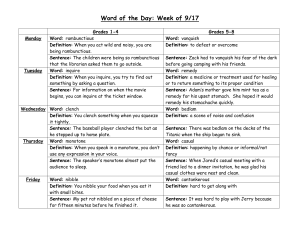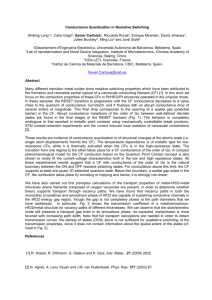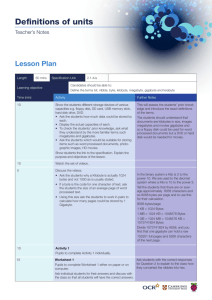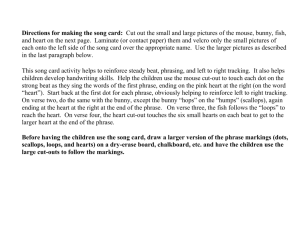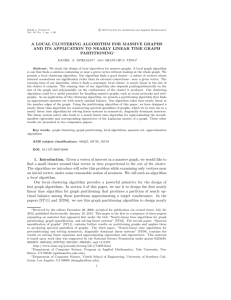290H Final Report - UCSB Computer Science
advertisement
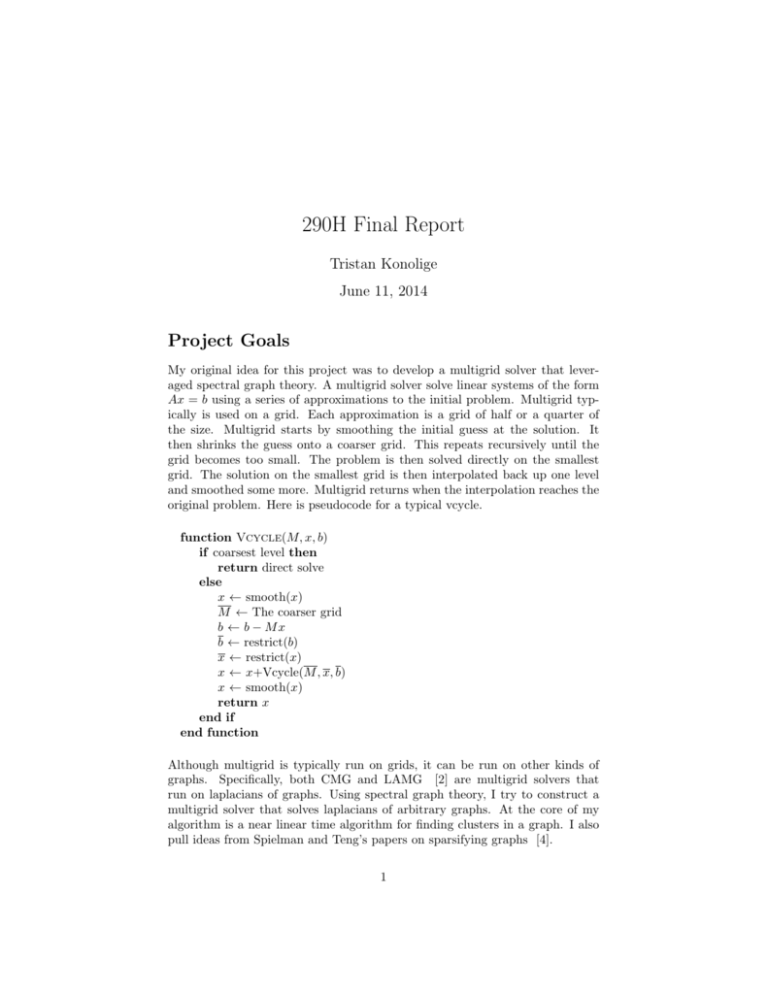
290H Final Report Tristan Konolige June 11, 2014 Project Goals My original idea for this project was to develop a multigrid solver that leveraged spectral graph theory. A multigrid solver solve linear systems of the form Ax = b using a series of approximations to the initial problem. Multigrid typically is used on a grid. Each approximation is a grid of half or a quarter of the size. Multigrid starts by smoothing the initial guess at the solution. It then shrinks the guess onto a coarser grid. This repeats recursively until the grid becomes too small. The problem is then solved directly on the smallest grid. The solution on the smallest grid is then interpolated back up one level and smoothed some more. Multigrid returns when the interpolation reaches the original problem. Here is pseudocode for a typical vcycle. function Vcycle(M, x, b) if coarsest level then return direct solve else x ← smooth(x) M ← The coarser grid b ← b − Mx b ← restrict(b) x ← restrict(x) x ← x+Vcycle(M , x, b) x ← smooth(x) return x end if end function Although multigrid is typically run on grids, it can be run on other kinds of graphs. Specifically, both CMG and LAMG [2] are multigrid solvers that run on laplacians of graphs. Using spectral graph theory, I try to construct a multigrid solver that solves laplacians of arbitrary graphs. At the core of my algorithm is a near linear time algorithm for finding clusters in a graph. I also pull ideas from Spielman and Teng’s papers on sparsifying graphs [4]. 1 The Nibble Algorithm Nibble is a near linear time algorithm for finding low conductance clusters near a given node in a graph. Nibble’s running time is O(2b(log6 m)/θ4 ). Nibble works by running an approximate truncated random walk from a starting vertex [3]. If the walk does not mix rapidly, then Nibble will return a set with low conductance. Conductance is defined as: Φ(S) = |E(S, V − S)| min(vol(S), vol(V − S)) Where vol is the volume of the set: X degree(i) i∈S Conductance measures the ratio between the number of edges leaving a set vs the number of edges in that set. How good of a set Nibble finds is controlled by the parameter θ. Nibble with find a set with conductance of at most θ or return an empty set. The size of the set Nibble find is controlled by b. Nibble will find a set of at most size 2b . Problems with Nibble For small values of θ, Nibble can run for too many iterations. Nibble runs dlog2 (vol(V )/2)e ∗ d p 2 ln(200(dlog2 (vol(V )/2)e + 2) vol(V )/2e 2 θ random walk steps before it will return an empty set. If θ is small and there is no set of conductance θ then θ22 becomes very large. This becomes an issue later on when I implement the sparsification algorithm presented by Spielman and Teng [4]. To combat this issue, I fixed the number of iterations to a constant. Theoretically this makes Nibble less likely to find the correct set, but in practice it made no difference. The graphs I worked with were not large enough to require a cut of such low conductance. Furthermore, I only care about very quick results. Nibble has a variety of fixed constants. Spielman and Teng [3] provide constraints on these values and give suitable values. These constants govern number of iterations, size of truncated values in the random walk, and stopping conditions. While the provided constants worked fine in practice, I believe that a better choice of values would improve performance of Nibble. On graphs with narrow width, the random steps of Nibble can quickly cover the entire graph. This is not optimal for performance. Furthermore, my implementation of Nibble used a very slow algorithm for computing each random step. When I scaled up my graph sizes during tests, each random step would take seconds. This is clearly unacceptable for a ”fast” clustering algorithm. A quick solution was to truncate the search more aggressively. However, this sacrificed likelihood of finding a good set of low conductance. 2 Modified Nibble The version of Nibble I’m using has some significant changes from the original. function Nibble(G, v, θ, b) v is a vertex 0<θ<1 b is a positive integer ← 1/(c3 (l + 2)tlast 2b ) . Constants are defined in [3] q ← The vector with a 1 at position v for t ← 1 to 100 do q ← [M q] . A single step of random walks if there exists a j such that Φ(Sj (q)) ≤ θ, vol(Sj ) ≤ (5/6)vol(V ), 2b ≤ vol(Sj ), q[j] ≥ 1/(c4 (l + 2)2b ) then return Sj end if end for end function Notice that the loop runs a maximum of 100 times. Partitioning with Nibble Nibble can be used to partition a graph. The algorithm for partitioning is fairly simple. Nibble is repeatedly called with random starting vertices. The results are unioned with previous Nibbles to form the cut. This procedure is stopped when the cut reaches the desired size. By taking advantage of Nibble, the partition algorithm runs in O(m log(1/p) log7 m/θ4 . This algorithm is later used to sparsity the graph. Spectral Sparsification One possible way to perform aggregation is by sparsifying the initial graph. By removing edges of a graph, we can get an approximating of the original. This is governed by which defines an partial ordering on graphs. is defined as follows: G H ⇐⇒ xT LG x ≤ xT LH x ∀x If G H then we can use G as an approximating of H. Spielman and Teng [4] provides an algorithm that takes advantage of this to create sparsified versions of graphs. This algorithm uses the partitioning algorithm presented above. Partition is repeated called to approximate a sparse cut in the graph. The results are then joined together to get a good approximation at the cut. There 3 is a high likelihood that partition find a large cut or overlaps with much of the sparsest cut [4]. Given a small sparsest cut, it is likely that the complement is a subgraph of high conductance [4]. Using this fact Spielman and Teng [4] construct a recursive algorithm to sparsity a graph. If a graph has high conductance, then it can be approximated by randomly sampling its edges with probability relative to the minimum degree of the vertices connected by the edge. They repeatedly call their approximate cut algorithm. If a small cut is returned, they randomly the complement, otherwise they recursively proceed on each side of the cut. Using this algorithm, a theoretical running time of O(m log(1/p) log1 5n) is achieved. Issues with Sparsification The sparsification algorithm presented by Spielman and Teng has a few issues that showed up when I attempted to implement it. - The starting conductance for Sparsify was too low for all graph I tested. Sparsify uses a starting conductance of 2∗log 1 vol(V ) . Given a 5x5 grid graph with volume 100, starting 29/28 conductance is 3.8×10−3 . There is no set in this graph that has conductance less than or equal to 3.8×10−3 . For all the graphs I tested, this caused the algorithm to terminate without sparsifying the graph. By fixing the starting conductance to a relatively high value, I was able to make Sparsify find nonempty sets in the graph. Like Nibble, Sparsify has a number of constants. Unlike Nibble, suitable constants for these values are not given. These constants govern the stopping conditions for Sparsify (c3 ) and the conductance value passed to Nibble (c4 ). I initially tested values of 1 for both of these. Using c3 = 1, Sparsify would immediately hit its stopping condition without sparsifying any of the graph. By tweaking c3 ’s value I was able to get Sparsify to not stop immediately on my test graphs. However, c3 had to be set on a graph by graph basis. This is not acceptable for a practical algorithm. My stopgap solution was to terminate recursion when the graph achieved a desired size. The other constant, c4 proved to be useless. c4 governs how much the desired conductance shrinks when attempting to find an approximate cut in the graph. This shrinkage of conductance presents its own problem and is discussed in the next issue. 1 At each call to partition, the conductance passed is 1000 of the starting conductance. As partition is called on a subgraph of the original graph, it would make more sense to increase conductance rather that decrease it. However, this reduction in conductance can serve as a stopping condition on the recursion. Trying to find smaller cuts is more likely to return an empty set, stopping Sparsify from continuing to partition. This reduction in conductance does not work in practice. As mentioned earlier, sets with conductance less than or equal to this reduced value do not exist. This causes Nibble and Partition to return empty sets before Sparsify has recursed at all. Furthermore, passing low conductance values to Nibble causes it to run for many iterations. This makes the algorithm run at a glacial pace. It may be possible to reduce conductance 4 by a reasonable value and get results. In an attempt to get Sparsify to return a reasonable sparsified graph, I removed the reduction of conductance. This allowed Sparsify to return results. The results returned by my modified version of Sparsify were not satisfactory. All of the time, the sparsified graph returned was not fully connected. This is most likely not a bug in the original algorithm, but a bug in my implementation of it. While I spent some time looking for it, I could not find it. I decided that there was an easier way to use Nibble and Partition in my multigrid scheme. Nibble for restriction Multigrid requires a way to approximate a graph with a smaller graph. Spectral graph theory defines a partial ordering on graphs using the . Can I construct a restriction operator that finds a G such that G L? I know that Spielman and Teng solve this problem by removing edges from the graph. However, when I implemented the Sparsify algorithm it required parameter turning to even return results. Even once it returned results, these results did not work in multigrid. When used in my multigrid scheme, interpolation would increase the residual instead of decreasing it. This is most likely because my Sparsify algorithm does not work correctly. As mentioned above, it always returns graphs that are not fully connected. Instead I thought I could find a different restriction operator. While Spielman and Teng remove edges to sparsify a graph, I merge vertices together. This is similar to what happens with restriction on the model problem. In a one dimensional grid, the size of the grid is halved with every restriction. The typical 1-D restriction scheme is shown in the figure above. Notice how three adjacent nodes are merged into one node. I use Nibble to find sets of vertices to merge. The intuition is that Nibble returns sets of low conductance. That means vertices in the set are more likely to be closer to each other than other to other vertices in the graph. The algorithm I use for restriction is simple. Nibble is called on random vertices until there are no vertices that are not in a Nibble set. The pseudocode for that is here: 5 function coarsen(G, θ, b) S←V D←∅ while |S| > |V5 | do v ← a node selected at random from S N ← Nibble(G, v, θ, b) Append N to D S ← S−D end while . The set of all vertices . A set of sets G0 ← empty graph for every set si in D do for every vertex v in s do for every other set sj in S do if v ∈ sj thenadd an edge from i to j to G0 end if end for end for end for return (G0 , D) end function Sets returned by Nibble can overlap. This is not an issue. In multigrid on a grid, restricted sets all overlap. All sets returned by Nibble will be about the same size. Nibble is guaranteed to return a set around 2b . In my tests, I used b = 2. This gives set of around 4. Another option is to select b with probability such that b is in the range [1, 3]. This is the approach that Spielman and Teng take. In the future, I plan to to try various other values of b. The coarsen algorithm code only solves the problem of constructing the coarser graph. However, we still need to restrict x and b to get vectors that fit the coarser graph. The weighting scheme on a one dimensional grid is [1/4, 1/2, 1/4]. The 1/4 overlaps with the neighbors. I could not find any good theory on restriction in multigrid. One thing I noticed is that the sum of all the ratios add up to 1. Keeping this in mind, this is what I came up with this for my restriction operator: function restrict(S, x) . S is the set of sets constructed in coarsen x ← vector of all 0s for set si in S do for vertex v in si do x[i] ← x[i] + x[i]/|si | end for end for return x end function 6 This restriction scheme works fairly well in practice. For a path graph like the one dimensional grid, my restriction operator is exactly the same as the typical restriction operator. In the future I believe I could add the degree of each node to the restriction operator. Here is the complete vcycle using Nibble: function vcycle(G, x, b, θ, p) if coarsest level then return direct solve else x ← smooth(x) G ← coarsen(G, θ, p) b ← b − Gx b ← restrict(G, b) x ← restrict(G, x) x ← x+vcycle(G, x, b, θ, p) x ← smooth(x) return x end if end function Performance of this algorithm is still in flux. Currently, interpolating up from a coarser grid increase error instead of decreasing it. Furthermore, the restricted b loses orthogonality to the null space. This causes smoothing operations to do no work. Future Work Clearly, there is still a lot of work to be done. My first goal is to make the restriction operator maintain orthogonality of b. This is most likely the reason why my multigrid scheme is not working. I need to further experiment with the restriction operator. I believe that weighting nodes in restriction by their degree might have a benefit. The slowest part of my multigrid algorithm is Nibble. The slowness is due to my implementation. Improving my implementation of Nibble would have a huge difference on the speed of the multigrid algorithm. An alternative is to implement Nibble-Pagerank by [1]. This algorithm is functionally equivalent to Nibble but runs in faster time. Both Nibble and Sparsify have constants that govern how they run. Experimenting with different values for these constants might yield improvements on accuracy and running time. I would like to throw an optimizer at the constants and see what values it returns across multiple graphs. 7 References [1] Reid Andersen, Fan Chung, and Kevin Lang. Local graph partitioning using pagerank vectors. In Foundations of Computer Science, 2006. FOCS’06. 47th Annual IEEE Symposium on, pages 475–486. IEEE, 2006. [2] Oren E Livne and Achi Brandt. Lean algebraic multigrid (lamg): Fast graph laplacian linear solver. SIAM Journal on Scientific Computing, 34(4):B499– B522, 2012. [3] Daniel A Spielman and Shang-Hua Teng. A local clustering algorithm for massive graphs and its application to nearly-linear time graph partitioning. arXiv preprint arXiv:0809.3232, 2008. [4] Daniel A Spielman and Shang-Hua Teng. Spectral sparsification of graphs. SIAM Journal on Computing, 40(4):981–1025, 2011. 8


